17.210.060 Review process.
The following provisions relate to applications for a franchise or small cell permit for small cell deployments:
(1) Review of Facilities. Review of the site locations proposed by the applicant shall be governed by the provisions of 47 U.S.C. 253 and 47 U.S.C. 332 and applicable case law. Applicants for franchises and the small cell permits which implement the franchise shall be treated in a competitively neutral and non-discriminatory manner with other service providers utilizing supporting infrastructure which is functionally equivalent, that is, service providers whose facilities are similarly situated in terms of structure, placement or cumulative impacts. Franchise and small cell permit review under this chapter shall neither prohibit nor have the effect of prohibiting the ability of an applicant to provide telecommunications services.
(2) Concealment for Small Cell. In any zone not designated for design review, upon application for a small cell permit or for facilities designated within a franchise, the city will permit small cell deployment on existing utility poles conforming to the city’s generally applicable pole design standard adopted pursuant to city code or street and utility standards. Accordingly, small cell facilities installed pursuant to this concealment authorization may not be expanded pursuant to an eligible facilities request unless the director determines that such expansion does not defeat the concealment elements of the facilities as outlined in this chapter. The applicable design standards are as follows:
(a) Design Standards.
(i) No Co-location. Each wooden utility pole may not contain more than one small cell facility.
(ii) Height Restrictions. All small cell facilities shall be in compliance with height restrictions applicable to poles and other structures as stated in Chapter 17.220 SMC. The director may approve deviations as described in this chapter.
(iii) New and Replacement Poles. The new or replacement poles shall match height, color and material of the original or adjacent poles and shall be subject to approval by the director. The director may approve deviations as described in this chapter.
(iv) Interior Concealment. Whenever technologically feasible, antennas and equipment shall be fully concealed within the utility or light pole. When interior concealment is not possible, such as when attached to a wooden utility pole or due to Americans with Disabilities Act (ADA) requirements, antennas and equipment shall be camouflaged to appear to be an integrated part of the utility or light pole.
(v) Flush-Mounted Standoff Brackets or Pole-Top Antennas. In situations when interior concealment pursuant to subsection (2)(a)(iv) of this section is not possible, installation of an antenna on a pole shall be flush mounted if feasible or located at the top of the pole. Flush mounting includes using brackets that offset the inside edge of such equipment from the utility pole by 12 inches or less, except as otherwise required by the pole owner or a controlling electrical code such as the National Electrical Safety Code, National Electric Code or State Electrical Code and when approved by the city. Standoff brackets are permitted so long as the antennas are mounted as close to the pole as technically feasible, but no more than 12 inches off the pole.
(vi) Antenna Design. Antennas shall be located in an enclosure of no more than three cubic feet in volume, or in case of an antenna that has exposed elements, the antenna and all of its exposed elements could fit within an imaginary enclosure of no more than three cubic feet. No more than four antennas are permitted on a single utility pole and with a total volume not to exceed nine cubic feet.
(vii) Primary Equipment Enclosure Location and Dimensions. The applicant shall minimize the primary equipment enclosure space and use the smallest amount of enclosure possible to fit the necessary equipment. The primary equipment enclosure shall be located using one of the following methods:
(A) Concealed completely within the pole or pole base. If within the pole base, the base shall meet the ADA requirements and not impact the pedestrian access route.
(B) Located on a pole. If located on a pole, the equipment enclosure shall be 17 cubic feet or less in size.
(C) Underground in a utility vault. If located underground, the access lid to the primary equipment enclosure shall be located outside the footprint of any pedestrian curb ramp and shall have a nonskid surface meeting ADA requirements if located within an existing pedestrian access route.
(D) On private property. If located on private property, the applicant shall submit a copy of an executed easement or lease agreement with the private property owner prior to the right-of-way permit issuance. In addition, if the private property is zoned residential, the applicant shall comply with the requirements of applicable zoning code chapter.
(viii) Material and Color. Small cell facility antennas, conduit, mounting hardware and cabinets shall be painted to match the color of the pole and shall be nonreflective.
(ix) No Illumination. Small cell facilities shall not be illuminated.
(x) Generators and Backup Battery. Applicant shall not install any generators or backup battery power.
(xi) Underground Areas and Design Zone Aesthetics. The design plans for all small cell facilities in design zones shall be compatible with the character and aesthetics of the neighborhoods, plazas, boulevards, parks, public spaces, and commercial districts located in whole or in part within the design zone. Applicant shall propose design concepts and the use of camouflage or stealth materials, as necessary to blend its installations with the overall character of the design zone. Applicants are encouraged to meet with the city prior to submitting a concealment element plan subject to this section and other applicable city code.
Examples of Unacceptable and Acceptable Small Cell Facilities
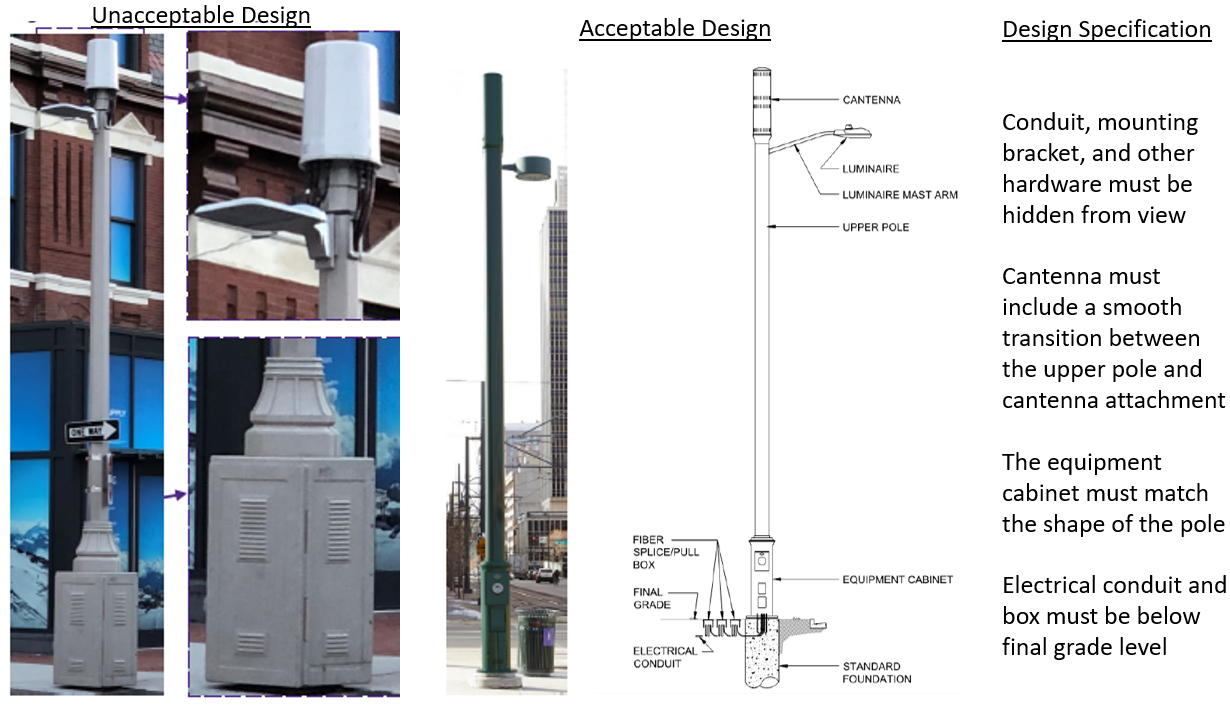
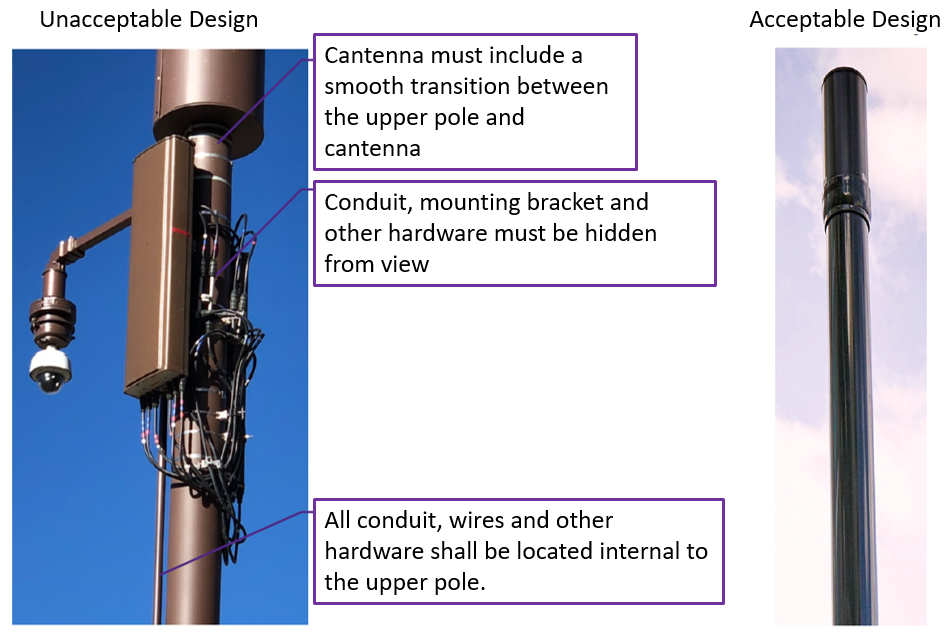
Examples of a Poorly Designed Small Cell Facility
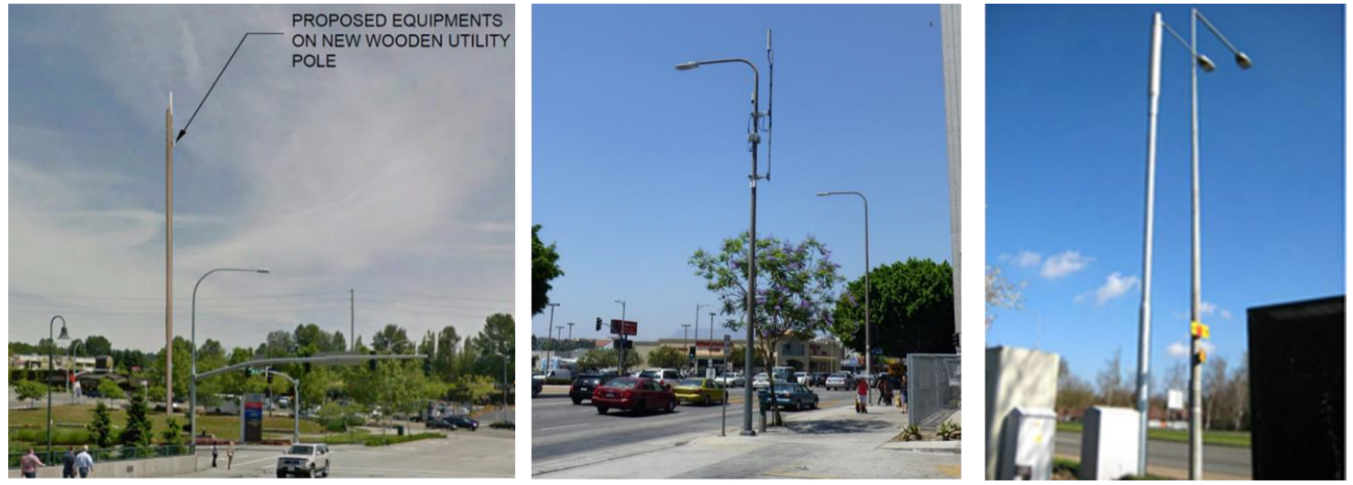
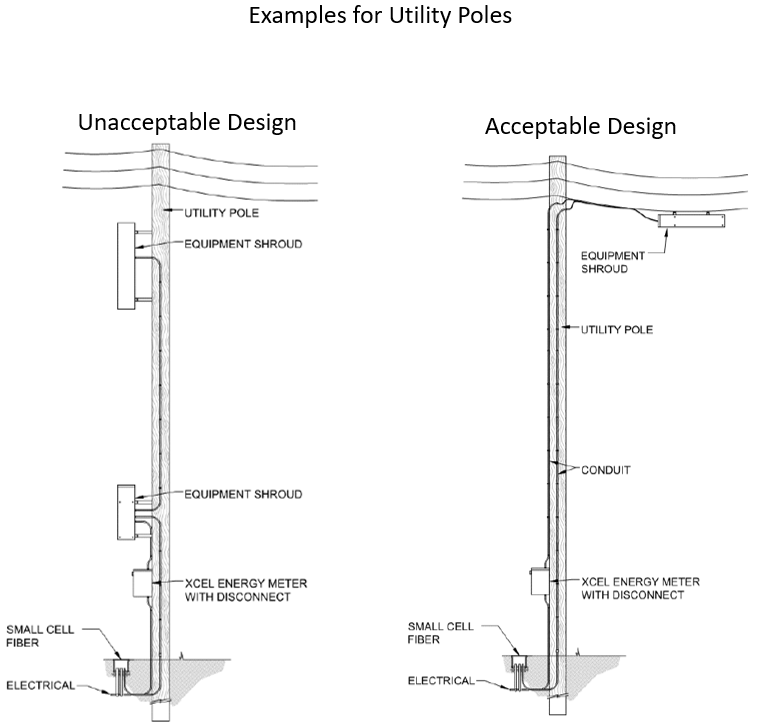
Examples of Utility Pole Design
(Subject to Approval of the Utility)
(xii) Placement Requirements. Small cell facilities and street light poles shall only be located where an existing pole can be removed and replaced or at a new location where it has been identified that a streetlight is necessary. Poles shall be placed as follows:
(A) In a manner that does not impede, obstruct, or hinder pedestrian or vehicle travel.
(B) In alignment with existing trees, utility poles, and streetlights. Placement should be within the street amenity zone.
(C) Equal distance between trees when possible, with a minimum of 15-foot separation such that no proposed disturbance shall occur within the critical root zone of any tree.
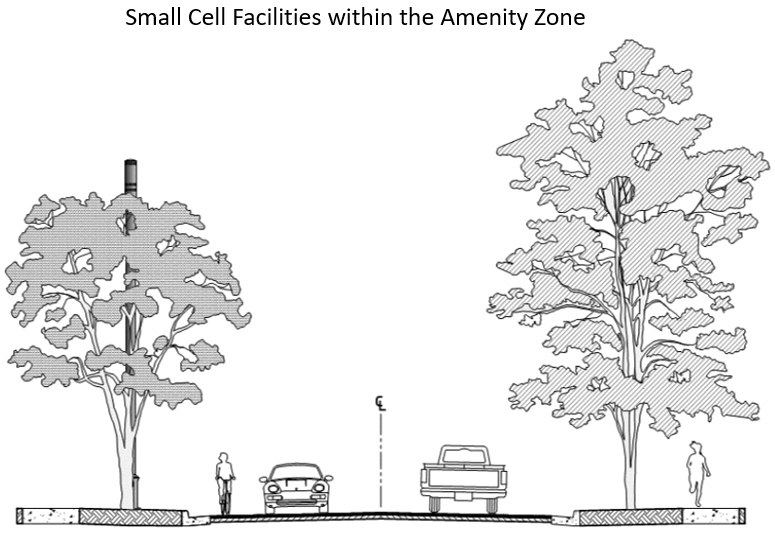
(D) With appropriate clearance from existing utilities.
(E) Outside the sight distance triangle at intersections; including alleys.
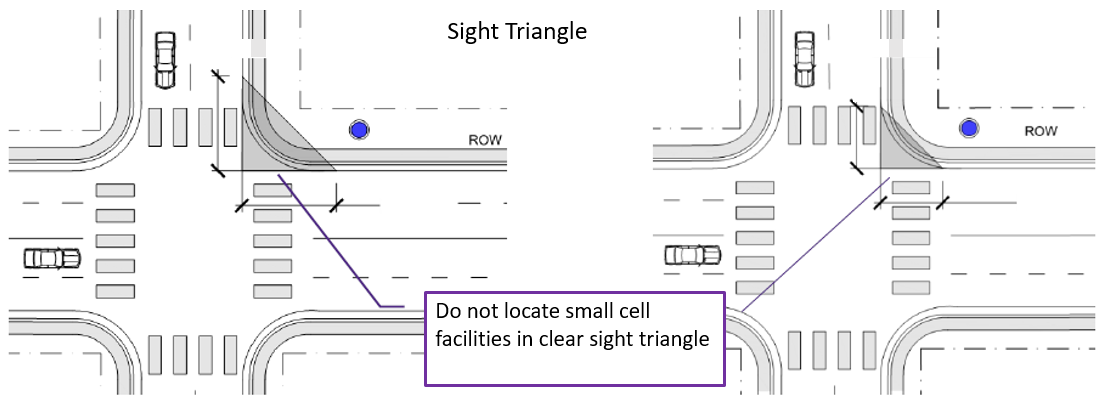
(F) New standalone poles shall be separated by at least 250 feet in circumference.
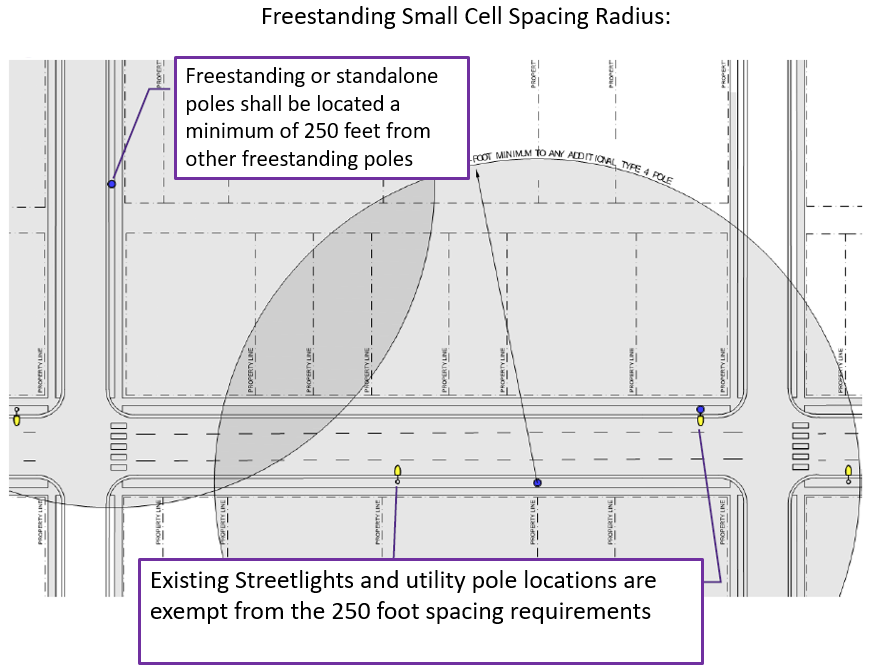
(G) Small cells shall not be installed between the perpendicular extension of the primary street facing wall plane of any single-family residence.
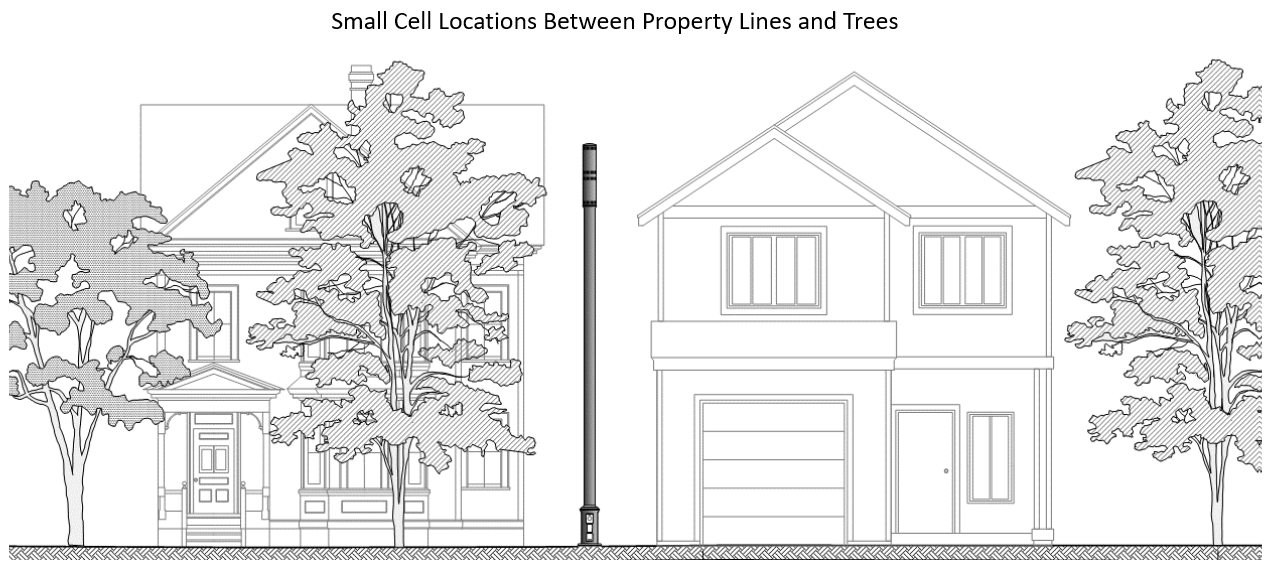
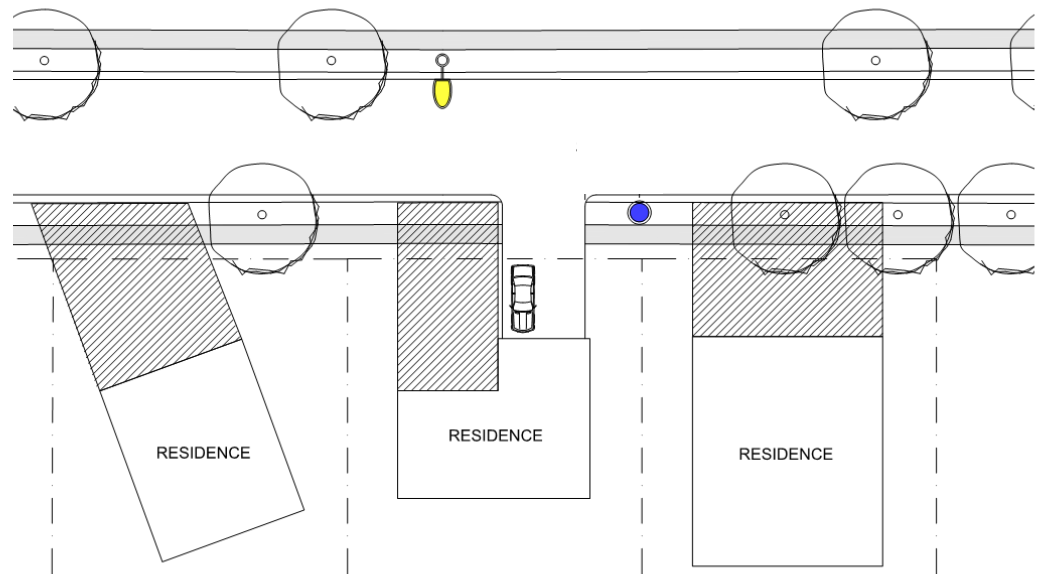
(H) When located adjacent to a commercial establishment, small cells shall be located away from storefront windows, primary walkways, entrances or exits.
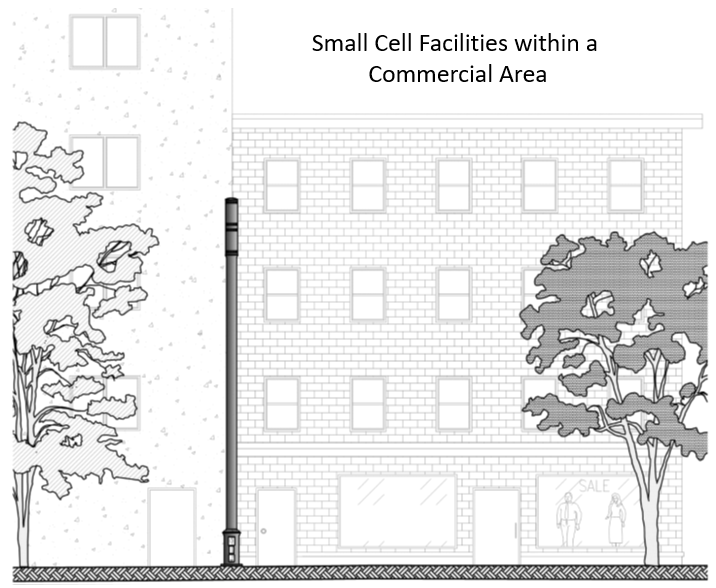
(b) Third Party Requirements.
(i) All installations of small cell facilities must have permission from the pole/structure owner to install facilities on such structure.
(ii) Governing Construction or Electrical Code. All installations of small cell facilities shall comply with any governing construction or electrical code such as the National Electrical Safety Code, the National Electric Code or State Electrical Code, as applicable. All installations of ground-mounted or replacement structures shall comply with the city’s adopted standards for construction in the right-of-way.
(iii) Electrical Connection. The city is not responsible for providing electricity to small cell facilities. Any third party utility providing such electricity must obtain a franchise from the city prior to operating in the rights-of-way.
(iv) Transport/Telecommunications Connection. The city is not responsible for providing transport connectivity (i.e., fiber) to small cell facilities. Any third party utility providing such transport connectivity must obtain a franchise from the city prior to operating in the rights-of-way.
(3) Ground-Mounted Equipment – ADA Compliance Required. In areas of the city where overhead utility lines have been undergrounded (undergrounded areas), in designated design zones and in other areas where necessary to permit full use of the public right-of-way by pedestrians, bicycles and other users, all ground-mounted equipment shall be undergrounded in a vault meeting the city’s construction standards. The location of ground-mounted equipment (to the extent undergrounding such equipment is not technologically feasible), a replacement pole or street light shall comply with the Americans with Disabilities Act (ADA), city development standards, and state and federal regulations in order to provide a clear and safe passage within the public right-of-way. Ground-mounted equipment is also permitted on private property adjacent to the public right-of-way with a recorded easement or lease agreement.
(4) Design Review. Small cell deployment, as well as certain new or replacement facilities, are subject to applicable design review and other zoning code requirements as set forth in the Stanwood Municipal Code.
(5) Public Comment. The city shall provide notice of a complete application for a franchise on the city’s website with a link to the franchise application. This notice requirement shall also apply to existing franchisees applying for a small cell permit for small cell deployment. The notice shall include an email contact and telephone number for the applicant to answer citizen inquiries. The applicant is encouraged to host informational meetings for the public regarding the deployment. The city shall post meeting notices, if any, for informational meetings on its website. These meetings are for the public’s information and are neither hearings nor part of any land use appeal process. (Ord. 1469 § 6 (Att. E), 2019).